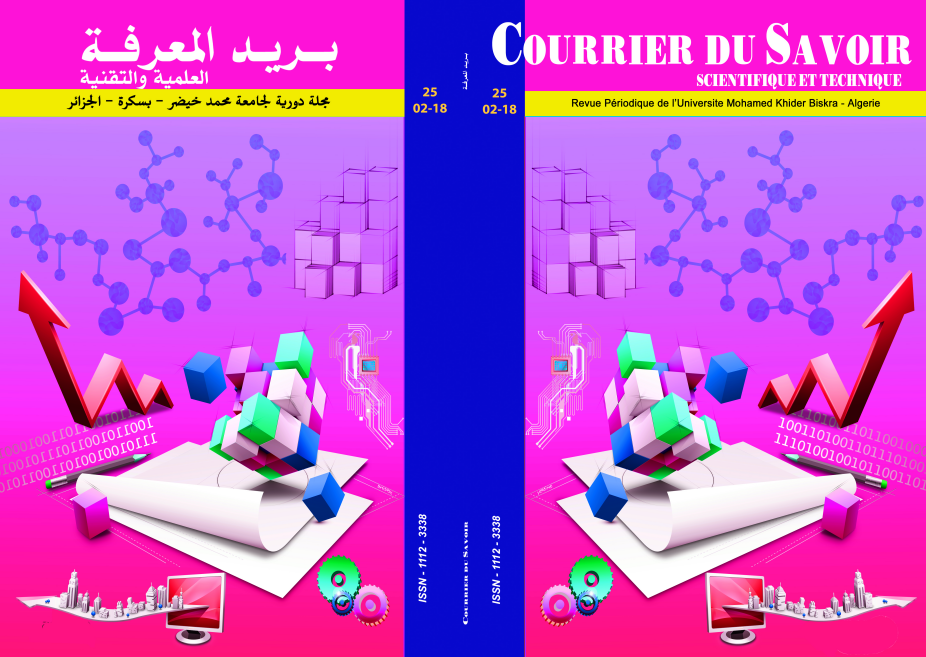ANALYSE ECO-BOTANIQUE COMPARATIVE DE DEUX POPULATIONS DU Pistacia atlantica EN ALGERIE PAR LE BIAIS DE MARQUEURS MORPHOLOGIQUES FOLIAIRES
Résumé
RESUME
La sauvegarde des écosystèmes forestiers et steppiques passe nécessairement par la connaissance des exigences écophysiologiques des genres et espèces qui y sont largement présents. Parmi ces espèces, nous citons Pistacia atlantica (pistachier de l’Atlas), ce dernier est adapté aux différentes conditions climatiques et se caractérise par une grande plasticité. Cette étude se propose d’identifier cette espèce rustique dans son milieu naturel et permet également d’apporter les premiers éléments de réponses sur son comportement adaptatif vis-à-vis de l’environnement.
Ce travail vise à établir une étude descriptive macro-morphologique de Pistacia atlantica, provenant de deux stations localisées sous différents bioclimats en Algérie, avec une analyse de la variabilité morphologique intra et inter-populations par l’utilisation d’un total de 15 caractères quantitatifs et qualitatifs morphologiques des feuilles dans le but d’identifier et de mieux connaitre l’espèce, ce qui permet de conserver la diversité génétique de cette espèce autochtone qui reste méconnue et par conséquent très peu employée dans la préservation des écosystèmes forestiers et pré-forestiers malgré ses intérêts, aussi bien écologique qu'économique.
L’analyse statistique a permis de séparer les populations étudiées en deux groupes selon les variables étudiées et les conditions climatiques. Les dimensions des feuilles, le nombre de paires de folioles, longueur du pétiole, la forme de la foliole terminale, la forme du pétiole et la présence de trichomes, sont les caractéristiques les plus discriminantes. De même, les différentes adaptations observées lors de cette étude (variation dans la taille des feuilles) peuvent s’expliquer par la plasticité et la présence de cette espèce dans diverses conditions climatiques.
Mots clES: Algérie, feuille, macromorphologie, micromorphologie, Pistacia, trichomes, variabilité.
ABSTRACT
The protection of the forest and steppe ecosystems takes place inevitably by the knowledge of the genus and the species ecophysiological requirements which are widely present there. Among these species, we quote Pistacia atlantica (Atlas pistachio), which is adapted to the various weather conditions and is characterized by its big plasticity. This study suggests identifying this rustic species in its natural environment and also provides the first elements of answers on its adaptive behavior towards the environment.
This work aims at establishing a macro-morphological descriptive study of Pistacia atlantica, resulting from two stations located under various bioclimates in Algeria, with an analysis of morphological variability intra and inter-populations using a total of 15 quantitative and qualitative morphological characters of leaves with the aim of identifying and knowing better the species, which make it possible to preserve the genetic diversity of this native and autochthonous species which remains underestimated and consequently very little used in the conservation of the forest and pre-forest ecosystems in spite of its interests, so ecological as economic.
The statistical analysis allowed to separate the populations studied in two groups according to the studied variables and the weather conditions. The size of leaves, number of pairs of sepals, length of the petiole, shape of the terminal sepal, shape of the petiole and the presence of trichomes, are the most discriminating characteristics. Also, the various adaptations observed during this study (variation in the size of leaves) can be understandable by the plasticity and the presence of this species in various climatic conditions.


